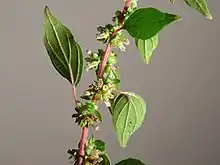Parietaria judaica
Parietaria judaica, with common names spreading pellitory or pellitory of the wall, is a species of herbaceous perennial plant in the family Urticaceae. The plant's pollen is highly allergenic.[2] In Australia it is also known as asthma weed, due to the high incidence of allergy.[3] It is unrelated to the herb pellitory (Anacyclus pyrethrum). It is easily confused with the very similar species Parietaria officinalis.[4]
| Parietaria judaica | |
|---|---|
 | |
| Plants of Parietaria judaica | |
| Scientific classification | |
| Kingdom: | |
| (unranked): | |
| (unranked): | |
| (unranked): | |
| Order: | |
| Family: | |
| Genus: | |
| Species: | P. judaica |
| Binomial name | |
| Parietaria judaica | |
| Synonyms[1] | |
| |
Etymology
Parietaria (Latin): Wall-dweller (a name used by the Roman naturalist and philosopher Pliny). Judaica (Latin): Of Judaea, Jewish, from Palestine.[5]
Description

The biological form of Parietaria judaica is hemicryptophyte scapose, as its overwintering buds are situated just below the soil surface and the floral axis is more or less erect. This plant has pink or red hairy stems, woody at the base. It reaches on average a height of 60 centimetres (24 in). The leaves are hairy, alternate, simple, entire and green, with smooth margins. The tiny white or pink flowers are attached to the stems. They are bisexual or unisexual, produced in clusters of three to many together in the leaf axils. The nickname sticky-weed is due to the adherent quality of the flowers and of the hairy stems; unlike some related species of the family Urticaceae, the hairs do not sting. The flowering period extends from spring through autumn, when it produces large amounts of pollen. The fruits are blackish achenes.
Distribution
Parietaria judaica is a native of Europe, central and western Asia and northern Africa.[6]
Habitat
Generally considered a weed, it is often found on roadsides, along dry stone walls and in cracks of buildings and rock faces. However it might be useful in a habitat garden within its native range, as it is a larval food plant for red admiral butterflies (Vanessa atalanta). Ideal habitats are dry and at an altitude of 0–1,000 metres (0–3,281 ft) above sea level. This species is wind pollinated.[8] Seeds are adhesive and transported by insects as well as other animals, people and machines.[9]
Gallery
 Parietaria judaica habit on wall
Parietaria judaica habit on wall.JPG.webp) Plant of Parietaria judaica
Plant of Parietaria judaica Stem and flowers of Parietaria judaica
Stem and flowers of Parietaria judaica.JPG.webp) Leaf of Parietaria judaica
Leaf of Parietaria judaica
References
- "Parietaria judaica", The Plant List, retrieved 2013-11-02
- Stumvoll S, Westritschnig K, Lidholm J, Spitzauer S, Colombo P, Duro G, Kraft D, Geraci D, Valenta R (May 2003). "Identification of cross-reactive and genuine Parietaria judaica pollen allergens". J. Allergy Clin. Immunol. 111 (5): 974–9. doi:10.1067/mai.2003.1376. PMID 12743560.
- Sydney Weeds Archived 2009-11-16 at the Wayback Machine
- Townsend, C.C. (1968). "Parietaria officinalis and P. judaica" (PDF). Watsonia. 6: 6. Archived from the original (PDF) on 2011-07-26.
- "Species Description: Parietaria judaica". CretanFlora.
- "Pellitory (Parietaria judaica)". NSW WeedWise. NSW Department of Industry.
- Ferrer, M.; Burches, E.; Peláez, A.; Muñoz, A.; Hernández, D.; Basomba, A.; Enrique, E.; Alonso, R.; Cisteró-Bahima, A.; Martín, S.; Rico, P.; Gandarias, B. (2005). "Double-blind, placebo-controlled study of immunotherapy with Parietaria judaica: Clinical efficacy and tolerance" (PDF). J Invest Allergol Clin Immunol. 15 (4): 283–292. PMID 16433210.
- "Parietaria judaica". Plants for a Future.
- "Parietaria judaica". New Zealand Plant Conservation Network.
External links
| Wikimedia Commons has media related to Parietaria judaica. |
- Jepson Manual Treatment: Parietaria judaica — invasive plant species Old link
- Parietaria judaica — U.C. Photo gallery
- Schede di bitanica
- "Parietaria judaica L." Atlas of Living Australia.